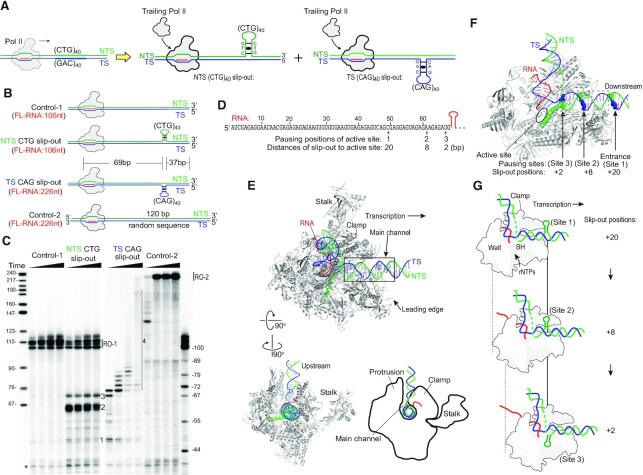Figure 3.
Analysis of the elongation complex paused on NTS CTG slip-out and TS CAG slip-out templates. (A) Scheme of transcription of the CTG•CAG tract induces the NTS CTG slip-out and TS CAG slip-out formation. (B) Diagram of the position of the slip-out structures in the DNA substrates. The size of the expected full-length RNA is indicated. (C) Mapping of RNA Pol II transcription blockage by the slip-out structures. Three distinct pausing sites before the hairpin runs into the active site (expected RNA size is 69 nt) were labeled. Markers on the left are a MspI digest of pBR322 plasmid. Markers on the right are different lengths of the transcript RNA, which are generated by Pol II transcription using the same DNA template but with limited UTP concentration to induce Pol II pausing. Asterisk indicates transcripts from reconstituted ECs that did not ligate to the downstream naked DNA. (D) The sequence of the transcript RNA before the slip-out structure region is shown on the top. The 3′ of the truncated RNA transcript and the distance of the slip-out structure to the active site when Pol II pauses are shown on the bottom. (E) The main channel of Pol II EC holds the downstream DNA. The PDB ID for Pol II EC elongation complex structure is 5FLM. The position of the downstream dsDNA outside of Pol II binding region was extended by coot with ideal B form duplex. (F) Positions of the slip-out structure when Pol II stalls. During transcription elongation, the main channel entrance edge detects the hairpin structure first and results in weak pausing (site 1), and then Pol II translocates forward and pauses at site 2, where the Pol II active site is at 8 nt upstream of the hairpin. Pol II further pauses when the hairpin runs close to the active site (site 3, where the Pol II active site is at 2–3 nt upstream of the hairpin). The main channel is shown in the dashed rectangle. (G) Diagram of the positions of slip-out when Pol II is stalled by these structures. The positions of NTS slip-out induced Pol II pausing are shown here.

